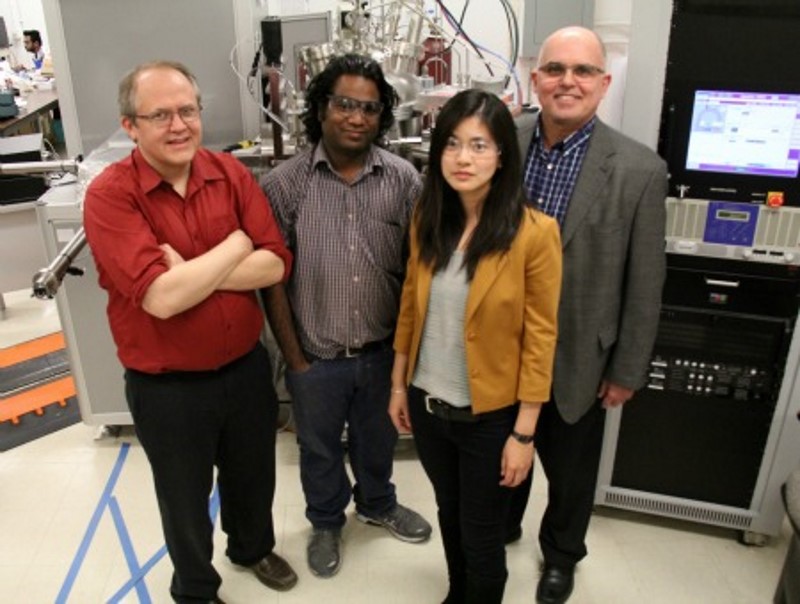- Home
- Science
- Science News
- New Thin Film Transistor May Lead to Flexible Electronics
New Thin Film Transistor May Lead to Flexible Electronics

Researchers were exploring new uses for thin film transistors (TFT), which are most commonly found in low-power, low-frequency devices like a computer display screen.
Efforts to improve the performance of transistors have been slowed by the challenges of developing new materials or slowly improving existing ones for use in traditional thin film transistor architecture, known as the metal oxide semiconductor field effect transistor (MOSFET).
Instead of developing new materials, researchers from the University of Alberta in Canada improved performance by designing a new transistor architecture that takes advantage of a bipolar action.
Instead of using one type of charge carrier, as most thin film transistors do, it uses electrons and the absence of electrons (referred to as 'holes') to contribute to electrical output.
Their first breakthrough was forming an 'inversion' hole layer in a 'wide-bandgap' semiconductor, which has been a great challenge in the solid-state electronics field.
"Once this was achieved, we were able to construct a unique combination of semiconductor and insulating layers that allowed us to inject 'holes' at the MOS interface," said Gem Shoute from University of Alberta.
Adding holes at the interface increased the chances of an electron 'tunneling' across a dielectric barrier. Through this phenomenon, a type of quantum tunnelling, researchers were able to achieve a transistor that behaves like a bipolar transistor.
"It is actually the best performing (TFT) device of its kind - ever. This kind of device is normally limited by the non-crystalline nature of the material that they are made of," said Ken Cadien from University of Alberta.
The dimension of the device itself can be scaled with ease in order to improve performance and keep up with the need of miniaturisation, an advantage that modern TFTs lack. The transistor has power-handling capabilities at least 10 times greater than commercially produced thin film transistors.
"Usually tunnelling current is considered a bad thing in MOSFETs and it contributes to unnecessary loss of power, which manifests as heat," said Shoute.
"What we have done is build a transistor that considers tunnelling current a benefit," she added.
The findings were published in the journal Nature Communications.
Catch the latest from the Consumer Electronics Show on Gadgets 360, at our CES 2026 hub.
Related Stories
- Samsung Galaxy Unpacked 2025
- ChatGPT
- Redmi Note 14 Pro+
- iPhone 16
- Apple Vision Pro
- Oneplus 12
- OnePlus Nord CE 3 Lite 5G
- iPhone 13
- Xiaomi 14 Pro
- Oppo Find N3
- Tecno Spark Go (2023)
- Realme V30
- Best Phones Under 25000
- Samsung Galaxy S24 Series
- Cryptocurrency
- iQoo 12
- Samsung Galaxy S24 Ultra
- Giottus
- Samsung Galaxy Z Flip 5
- Apple 'Scary Fast'
- Housefull 5
- GoPro Hero 12 Black Review
- Invincible Season 2
- JioGlass
- HD Ready TV
- Laptop Under 50000
- Smartwatch Under 10000
- Latest Mobile Phones
- Compare Phones
- Honor Magic 8 RSR Porsche Design
- Honor Magic 8 Pro Air
- Infinix Note Edge
- Lava Blaze Duo 3
- Tecno Spark Go 3
- iQOO Z11 Turbo
- OPPO A6c
- Samsung Galaxy A07 5G
- Lenovo Yoga Slim 7x (2025)
- Lenovo Yoga Slim 7a
- Lenovo Idea Tab Plus
- Realme Pad 3
- Moto Watch
- Garmin Quatix 8 Pro
- Haier H5E Series
- Acerpure Nitro Z Series 100-inch QLED TV
- Asus ROG Ally
- Nintendo Switch Lite
- Haier 1.6 Ton 5 Star Inverter Split AC (HSU19G-MZAID5BN-INV)
- Haier 1.6 Ton 5 Star Inverter Split AC (HSU19G-MZAIM5BN-INV)







![[Sponsored] Haier C90 OLED TV | Dolby Vision IQ, 144Hz OLED and Google TV in Action](https://www.gadgets360.com/static/mobile/images/spacer.png)









